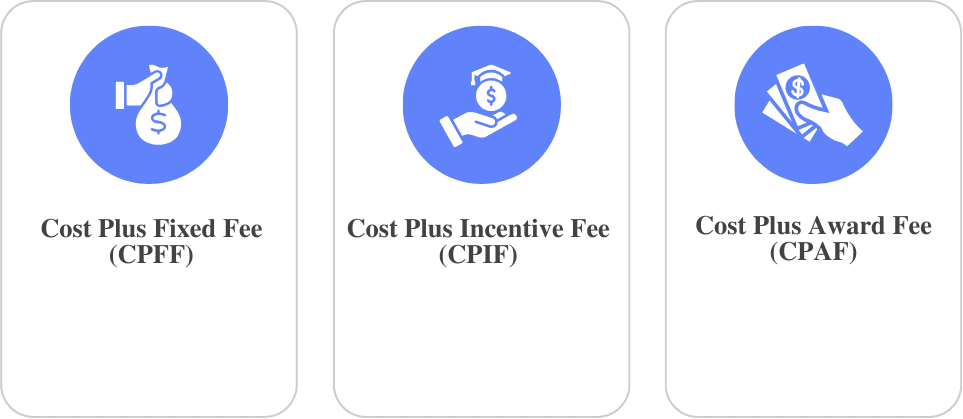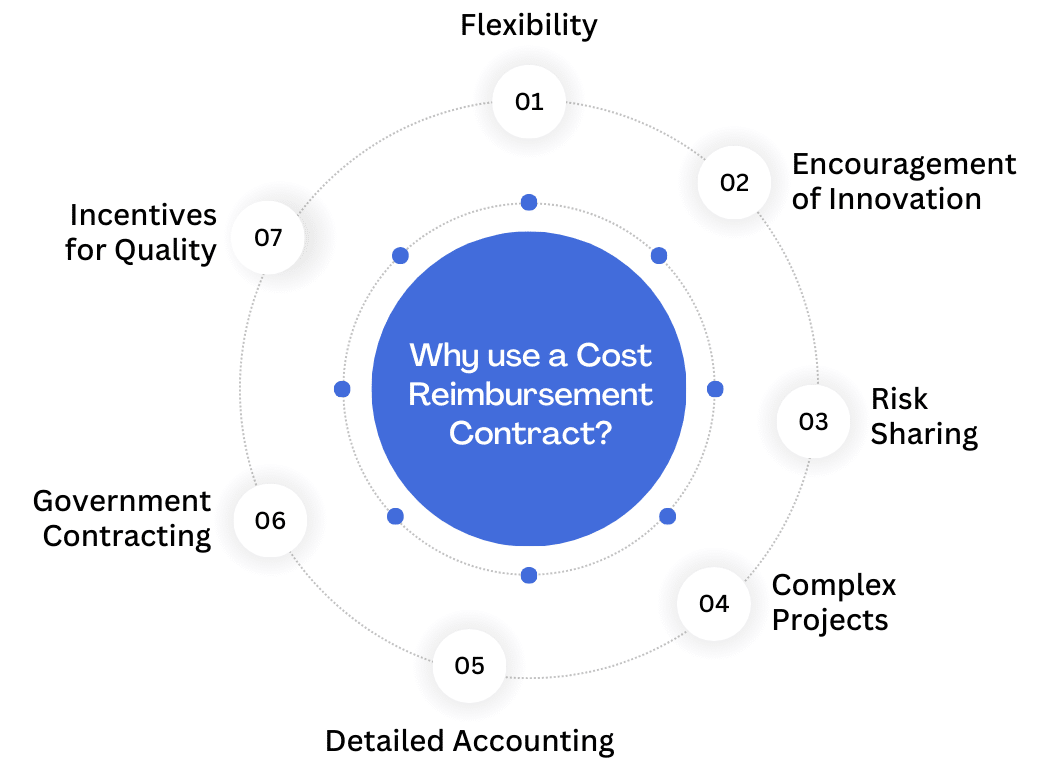In project management and contracting, understanding the intricacies of Cost Reimbursement Contracts (CRCs) is essential for both contractors and clients. These contracts serve as a vital framework, particularly when dealing with complex projects where costs can fluctuate and outcomes are uncertain. A CRC not only allows for flexibility in cost management but also promotes collaboration between the contracting parties, ensuring that the project aligns with its intended goals.
In this blog, we will delve into the essential components of Cost Reimbursement Contracts, including their definition, key elements, and the different types available. We will also discuss the advantages and potential challenges associated with these contracts, as well as best practices for effective management.
What Is a Cost Reimbursement Contract?
A cost reimbursement contract is a deal between a government agency and a prime contractor. In this agreement, the agency pays back the contractor for all permitted expenses during the project. Unlike fixed-price contracts, where the contractor bears most financial risk, cost reimbursement contracts put that risk on the government agency. This is because the total cost is not set in advance. It is figured out after the project ends or on a certain date in the contract timeframe.
While cost reimbursement contracts allow for flexibility, they need close cost tracking and clear records from the contractor. This helps keep everything transparent and accountable throughout the project.
Types of Cost Reimbursement Contracts
Understanding government contracts can be tricky. You need to know the different types of agreements available. Cost reimbursement contracts have several options to fit different project needs and risks.

Each type has its own rules, payment plans, and ways to share risks. To help you make the best decisions, let’s look closely at each category of cost reimbursement contracts and how they can be used in government projects.
Cost Plus Fixed Fee (CPFF)
Cost plus fixed fee (CPFF) contracts help the prime contractor get money back for costs they spend while working on the contract. Along with these costs, they also get a fixed fee that adds to their profit motive. These contracts work best when the scope of work is clear but still has some uncertainties that could need additional payments. The contractor has minimal responsibility in these contracts. The government accountability office watches closely to make sure cost control is effective and everything runs smoothly.
Cost Plus Incentive Fee (CPIF)
Under the cost plus incentive fee (CPIF) contract, the contractor gets a basic fee and an extra payment based on their performance. This arrangement encourages the contractor to save costs and meet targets efficiently. The contractor has little responsibility for controlling costs. However, with the profit motive pushing them to lower performance costs, the government gains from better contract performance. The CPIF structure gives flexibility and encourages timely development of all necessary cost data. This way, it helps create a successful partnership between the prime contractor and the contracting officer.
Cost Plus Award Fee (CPAF)
CPAF contracts are a kind of cost reimbursement contract. They include both fixed fees and award fees. This means contractors get extra money based on how well they perform. The prime contractor is paid back for allowable costs and gets added money as an award fee when they meet certain goals. These contracts help encourage good contract performance and reduce risks for the contractor. The contracting officer keeps a close eye on how the contractor is doing. They make sure the contractor follows the contract clauses and shares cost data on time. This is in line with the government’s focus on accountability and cost control.
You might want to read: NDAs (Non-Disclosure Agreements): A guide to secrecy
Key Components of Cost Reimbursement Contracts

Understanding cost reimbursement contracts is important for success. It’s not just about knowing the basic structure and fees. There are key parts that help make things clear and avoid conflicts during the contract’s life.
- Cost Reimbursement Structure: The contractor is reimbursed for allowable costs incurred during the project, up to a predetermined limit.
- Allowable Costs: Defined by the contract, these are costs that are reimbursable, such as labor, materials, and overhead, provided they meet the contract’s terms.
- Cost Ceiling: A maximum amount the client will pay for the project. Costs exceeding this limit are typically not reimbursed unless agreed upon.
- Fee Structure: This can include a fixed fee, incentive fee, or award fee in addition to the reimbursable costs.
- Audit Rights: The client may have the right to audit the contractor’s costs to ensure compliance with the contract terms.
- Risk Sharing: The client bears more financial risk, as they agree to reimburse actual costs, regardless of project outcome, up to the cost ceiling.
You might want to read: MSA Agreements: Your Guide to Master Service Agreement
Parts of a cost-reimbursement contract
A cost-reimbursement contract typically includes several key parts that define the responsibilities of both the contractor and the client, as well as how costs will be managed and reimbursed. Here are the essential components:
1. Legal Boilerplate
This section includes standard legal clauses covering the general terms and conditions of the contract. These terms typically include:
- Governing law
- Termination clauses
- Dispute resolution procedures
- Liability and indemnification
- Confidentiality agreements The boilerplate ensures the contract is legally enforceable and outlines how issues will be handled in case of disagreements.
2. Definition of Coverable Costs
This part specifies which costs are eligible for reimbursement. It typically breaks down costs into categories such as:
- Direct costs: Costs directly associated with the project, like labor, materials, and equipment.
- Indirect costs: Overhead costs like utilities, administrative expenses, and office supplies.
- Allowable costs: Expenses that comply with the terms of the contract and regulations (e.g., government contract rules). This ensures both parties have a clear understanding of what can and cannot be reimbursed.
3. Total Project Value
This section establishes the overall value of the project, which includes a cost ceiling or not-to-exceed limit. It sets the maximum amount the client will reimburse, ensuring that the contractor cannot exceed the agreed budget without approval. This part also outlines how payments will be structured, often with milestone-based payments or periodic billing.
4. Cost Estimates
Cost estimates provide a detailed breakdown of anticipated expenses across various phases of the project. Though actual costs may fluctuate, this section offers a baseline for what the contractor expects to spend. It is important for managing expectations and ensuring both parties agree on the financial scope of the project from the beginning.
Each of these parts works together to ensure transparency, control, and accountability in a cost-reimbursement contract, allowing for flexible budgeting while maintaining oversight of project costs.
Advantages of Cost Reimbursement Contracts:
- Flexibility: These contracts allow for adjustments if the project scope or costs change, making them ideal for complex or uncertain projects.
- Reduced Risk for Contractors: Contractors are reimbursed for all allowable expenses, minimizing financial risk and encouraging participation in challenging projects.
- Incentive for High-Quality Work: Since the contractor is reimbursed for actual costs, there’s less pressure to cut corners, leading to higher quality outcomes.
- Better Control Over Project Costs: Cost reimbursement contracts allow for ongoing oversight and detailed cost tracking, helping both parties monitor expenses.
- Encourages Collaboration: These contracts promote close cooperation between parties, as both have a vested interest in managing costs and meeting project objectives.
Examples of cost-reimbursement contracts
Imagine a government agency enters into a cost-reimbursement contract with a defense contractor to develop a new radar system. The development process is complex, and the exact costs of materials, labor, and testing are unpredictable. Under the contract, the contractor is reimbursed for all the costs incurred in the development process, such as engineering staff salaries, prototype materials, and testing equipment, as long as these costs are reasonable and justifiable. In addition, the contractor may receive a fixed fee as profit or an incentive fee based on achieving specific milestones, like completing the prototype by a certain deadline.
In this scenario, the cost-reimbursement structure encourages the contractor to move forward with innovation without worrying about underestimating the project’s budget, while the government retains oversight to ensure that the costs remain reasonable and aligned with the project’s objectives.
Challenges of Cost Reimbursement Contracts
Cost reimbursement contracts, where a contractor is paid for all allowed expenses to a set limit, can offer flexibility but also come with challenges:

- Cost Uncertainty: It can be difficult to accurately predict final costs, leading to budget overruns.
- Increased Oversight: The need for regular monitoring and audits adds administrative burden to both parties.
- Risk of Inefficiency: Since costs are reimbursed, contractors may lack incentive to control expenses efficiently.
- Complex Documentation: Extensive tracking and documentation of costs are required to ensure compliance, which can be time-consuming.
- Disputes Over Allowable Costs: Determining what constitutes an “allowable” expense can lead to disagreements between the parties.
These challenges require careful planning, clear communication, and thorough contract management to mitigate.
Conclusion
In summary, learning about cost reimbursement contracts is key to managing financial agreements in business. When organizations know the different types, parts, benefits, and issues related to these contracts, they can make better decisions that fit their goals. By adding important clauses, carefully watching expenses, and being flexible, businesses can improve their contracts for everyone’s benefit. Keep learning about contract management by using detailed guides like this one to boost your work efficiency and success.
Cost reimbursement contracts are a pivotal aspect of project management in the United States, particularly for complex undertakings where the contractor’s responsibility is defined by a specified level of effort and a stated time period. These contracts allow for flexibility in managing estimated costs, as they reimburse the contractor for allowable expenses incurred during contract work.
The proposed contract type typically outlines the additional fee that may be awarded, along with provisions for price adjustments based on performance and the contractor’s accounting system. In addition, various incentive contracts may be employed to motivate contractors, especially in situations involving concurrent operations or when delivering a specified end product.
By understanding the dynamics of cost contracts and the associated contractor risk, organizations can make informed decisions about the most suitable types of contracts for their projects, ensuring successful outcomes that align with their operational goals.
FAQs
1. How can businesses mitigate the risks associated with Cost Reimbursement Contracts?
To mitigate risks, businesses should closely monitor the contractor’s performance and accounting system. Establishing specific milestones, a target cost, and a written acquisition plan can help control expenses.
2. What is the difference between a Cost Reimbursement Contract and a Fixed-Price Contract?
In a Cost Reimbursement Contract, the contractor is paid for actual costs plus a negotiated fee, with no predetermined final price. In contrast, a Fixed-Price Contract sets a firm price at the outset, and the contractor assumes full responsibility for managing costs within that budget. Cost reimbursement is better suited for projects with uncertain scope, while fixed-price contracts are preferred for clearly defined work with limited risk.
3. How do you control costs in these contracts?
By setting target costs, monitoring contractor performance, and using clear milestones to track expenses.
4. How does it differ from a Fixed-Price Contract?
Cost reimbursement pays actual costs, while fixed-price contracts have a set budget the contractor must manage.






